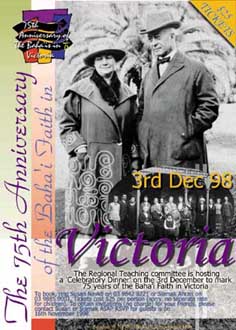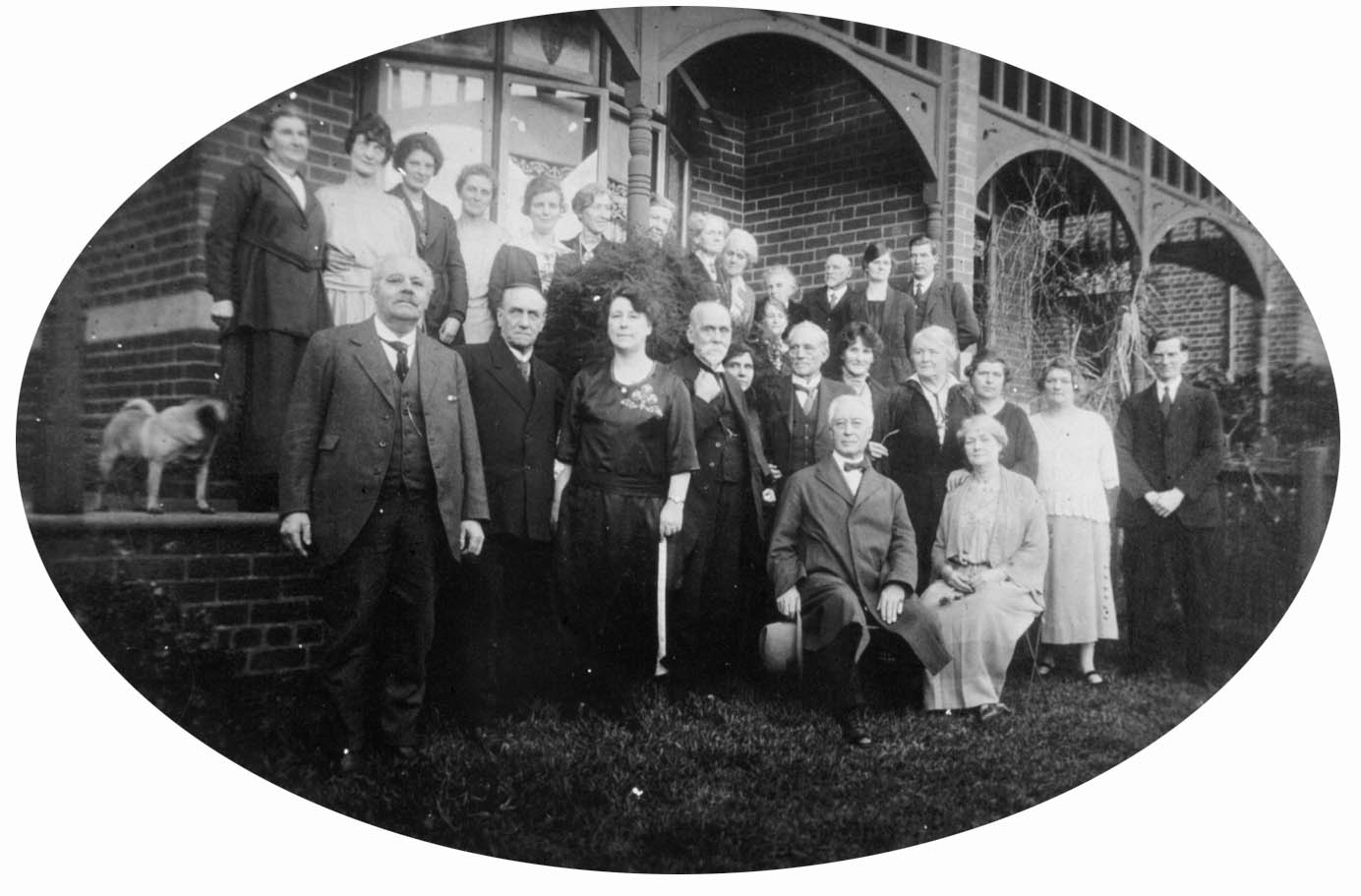
|
|
Abstract: History of the Bahá'í community of Victoria, Australia. Notes: Presented at a dinner marking 75 years of the Bahá'í Faith in Victoria, December 1998. |
 On 9th
December 1923 seventeen Bahá'ís gathered at the home of
Margaret Dixson, 82 Leopold Street, South Yarra, to form the
first Local Assembly of the Australian Bahá'í Community.
On 9th
December 1923 seventeen Bahá'ís gathered at the home of
Margaret Dixson, 82 Leopold Street, South Yarra, to form the
first Local Assembly of the Australian Bahá'í Community.
We meet tonight, three-quarters of a century later, to remember this event, and to remark on the progress that has been made through the decades. This is a gathering inspired by Faith and by history. We honour all who have taken part in the life of the Victorian Bahá'í Community or who have assisted it in some way.
Inspired by the Faith's founder, Bahá'u'lláh, and having met his son ‘Abdu'l-Bahá, Clara and Hyde Dunn arrived in Australia in 1920 to make known the Bahá'í Teachings. We live today in the shadow of their accomplishment - although we, as a Community, may barely know it. Who among us would dare compare their achievements with ours? Unaided by wealth, colleagues, professions or youth, they journeyed across the Pacific to an unfamiliar land and culture, armed solely with a sincere belief and a genuine love of all whose lives intersected with their own. They established Bahá'í Communities in all the major Centres and after a decade and a half witnessed the formation of the National Spiritual Assembly. When Shoghi Effendi heard of Hyde Dunn's death in 1941 he wrote to that body:
The community of the Most Great Name in those far-off islands has lost a great leader, a stalwart upholder of the New World Order of Bahá'u'lláh. The influence he has exercised will however continue to live, and the example he has set will inspire the rising generation to perform deeds as great and brilliant as those that will ever remain associated with his name. Our dear friend, Mr Hyde Dunn, will, from his exalted station intercede on your behalf, and you should, on your part strive to emulate one whom Bahá'í historians will recognise and acclaim as Australia's spiritual Conqueror.
The Assembly existed sporadically throughout the 1920s. It had a post box at the GPO in Bourke Street and rented a meeting room on the 4th floor of London Stores, No.11 Flinders Lane. There were more women than there were men and although mostly from the bright working class, representative also of Melbourne's leading figures. Mrs Jessie Henderson, President of the Victorian Branch of the National Council of Women, identified as a Bahá'í by September 1924 and was elected to the Assembly the following year. She was among the first to visit Bahá'í communities in England and North America.

By the early 1930s the Melbourne group was barely functioning and few meetings were being held. Its members had commenced with high hopes and ideals, but the difficulties of reconciling their diverse backgrounds and temperaments proved too great. The visit of Keith Ransom-Kehler in 1931 clarified the group's aims, and re-directed their attention to the need to set the Bahá'í message before the public. An article in the Melbourne Herald commenced:
"A City of warm hearts and cold houses" - that is how an American visitor, accustomed to central heating, sums up Melbourne... Fortunately she has remained long enough to find that there are some days when Melbourne homes do not need fires. Mrs Kehler is on a world tour spreading the goodwill gospel of the Bahá'í movement which aims to establish a universal peace among mankind…
When in 1934 the National Spiritual Assembly of the Bahá'ís of Australia and New Zealand was elected by delegates from the Sydney, Adelaide and Auckland Local Assemblies, the Melbourne group numbered less than nine. When Martha Root visited in 1939 there remained just three Bahá'ís in Melbourne to assist in organising her events. The early membership did not include families and hence lacked a ‘second generation’: members died, migrated, or drifted away.
Concerned to make progress in Melbourne, the National Assembly initiated a teaching campaign here that continued until reformation of the Assembly in 1948. It first appointed a Regional Teaching Committee in the 1940s (to coordinate activities in South Australia, Western Australia, Victoria, Tasmania and Broken Hill!). In January 1948 their were eight Melbourne members: Emily and Cyril Easey, Ron Cover and his mother Irene Cover, Freda Adams, Mrs E. Bennett, Madam Holden-Graham, and Eleanor Wheeler. Vi Hoehnke then moved from Sydney to make the ninth, the minimum number required for Assembly formation. In 1949 she was elected secretary of Melbourne Assembly, replacing Mrs Wheeler, who had occupied the position since 1938. When the community grew in number to about fifteen Miss Hoehnke moved to Ballarat, and in 1953, when the Bahá'í World commenced a global plan of expansion, she obtained a position as a nursing sister in what is now Papua New Guinea. In 1998 "sister Vi" continues to make her home in Port Moresby.
The Bahá'í Community in 1950 - 60
In the 1950s the number of Bahá'í Communities slowly increased, and constant efforts to increase awareness of the Teachings among the public and the authorities began to bear results. Ron Cover applied for and was granted leave for Bahá'í Holy days by the Education Department of Victoria, and Cyril Easey was granted similar leave by his employer, Kodak. In January 1950 the Melbourne Bahá'ís observed World Religion Day by holding a social hour in the Botanical Gardens. Public meetings and visiting lecturers began attracting articles in Smith's Weekly and The Argus and interviews on such radio stations as 3AW.
By 1953 there were Bahá'í Communities in Melbourne, Ballarat and Geelong, as well as Effie Baker at Goldsborough, Una Collins at Talgano, and Mr Willy Keipert (who had written to the National Assembly in 1945 saying that he was in No. 1 internment camp at Tatura, and that he had family members interned in Germany. His wife was born into a Bahá'í family in Iran and her children attended the Bahá'í school in Tehran.).
In 1957 the boundaries of Local Bahá'í Communities were re-drawn. The single community for metropolitan Melbourne became the Communities of Melbourne, Camberwell, Malvern, Caufield, Oakleigh, Mordialic and Brighton. Although the Bahá'í s had hoped to have Local Assemblies in Melbourne, Ballarat and Prahan by April 1963, only Ballarat's was formed.
In the early 1960s the Community remained small, but included members who were new, and of a younger generation: on the Regional Teaching Committee were Mary Ann McLeod, Murial Handley, and Bill Johnson. Other active members included Leila Deighton, Murial and Everard Handley, Jean Johnson, Christine and Allan Davis, Irene and Ron Cover, Ethel Sindrey, Pym Trueman, Pam Ringwood and Margaret Jackson. Iranian Bahá'ís also began to arrive, among them Manutschehr and Maliheh Gabriel in 1962, Aflatoon and Talieh Payman in 1966, Iraj and Mahvash Master in 1969. Unfortunately this short account cannot name all the Community's new members, nor do justice to describing their activities. In the intervening years the activities of Victoria's Bahá'í Communities at local and regional level have been many and varied.
The Bahá'í Community in 1998
The Victorian Bahá'í Community now comprises approximately 1600 adults, youth, and children, organised in more than 50 local communities, from more than 50 ethnic backgrounds and countries. Its members come from all continents, from the Pacific Islands, North and South East Asia, Europe, Africa, and the Americas. Its 29 Local Assemblies are located in all but four of Melbourne’s municipalities, and as far afield as Mildura, Ballarat and Wodonga. Its activities include promotion of the Bahá'í Teachings, the development of Bahá'í administrative institutions, provision of children and adults’ education; celebration of music, dance, and drama; utilisation of such media as press, radio, television and the internet; and the growth of families and wider social networks. In short, this is a diverse, talented, resourceful, energetic, and organically growing Community.
The Regional Teaching Committee encourages progress toward a ‘model community’, one that exemplifies the qualities the Universal House of Justice identifies with members of a ‘truly enlightened community’: ‘the high quality of their inner life and private character, the unified spirit of their association one with another, the rectitude of their conduct in relation to all, and the excellence of their achievements".

This Committee further sees the need for our Community to adopt the values of a 'learning organisation'. In the past two years it has implemented such processes as enhanced communicative capacity embracing printed newsletters, a website, an email list, and a regular "Community Forum" at Bahá'í House. We have instituted regular gatherings to welcome new members. We have sponsored the "Victorian Bahá'í Community Expo", an event that by its second year attracted more than 600 participants.
We wish to enhance the devotional aspect of Community life and thank the Port Phillip Bahá'ís for hosting the celebration of the holy day marking the Birth of Bahá'u'lláh in November, an event attended by more than 500 at the St Kilda Town Hall.
We want to offer more support to the Bahá'í Communities in Rural Victoria, and to this end recently held the second "Small Communities Conference" in Margaret Carey's adopted home-town of Dunkeld, close to the Grampians.
Our ability to undertake our current levels of activity has only been possible through the assistance of some twenty volunteers currently serving on our Offices of Communication, Youth, Education, and Human Resources. Please join us in thanking them for their sacrificial work, and offer them your support in order that our common goals may be realised.
As the summer approaches we have a team implementing a major project to foster the performing arts within the Bahá'í Community as a medium for promoting the idea of spirituality in an Australian setting. They too need your support and encouragement – remember to book your tickets for the two concerts at the Universal Theatre in Fitzroy or else for the concert in Bendigo. The Committee will announce other initiatives shortly: a regional celebration for Ayyám-i-Há, and a meeting for Local Assemblies as we approach completion of the current Four Year Plan.
We know activities within the Bahá'í Community are accompanied by extensive collaboration beyond it. Through involvement of parents in schools, professionals each in their field of expertise, in sports associations, in such service organisations as Rotary and Lion's Club, in regional multi-faith networks such as that in Greater Dandenong and that offered by World Conference on Religion and Peace, through youth movements including Girl Guides and Scouts, in the activities of the United Nations Association's Victorian Division, and through participation in programs of state and local governments, we celebrate the contribution that Bahá'ís are quietly making to the progress of Victoria's social, economic, and religious life.
We know, too, that the genesis of Bahá'í life is in the home, and that service to the Bahá'í Cause (or to any other worthwhile cause) requires judicious balance between the sacrifice of family time and attention to the needs of those who love and support us.
When we pause to consider the contribution made by Clara and Hyde Dunn to initiate our Community's existence, we might also wonder at how our own efforts will be viewed by those who come after us. Shoghi Effendi described Hyde Dunn as "great hearted and heroic". These are qualities our troubled world still sorely needs. Let us review tonight, as we enjoy the performances, the recollections, and each other’s company, our personal proximity to the qualities of a truly enlightened community – irrespective of the religious labels we happen to bear: the high quality of inner life and private character, the unified spirit of association one with another, rectitude of conduct in relation to all, and excellence of achievements.